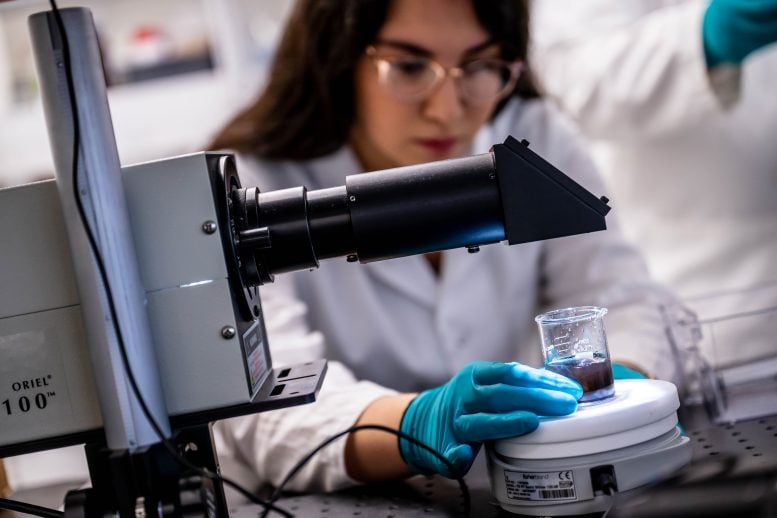Chemical engineers at the University of British Columbia have created a new system that both captures and treats PFAS substances—commonly referred to as “forever chemicals”—in a unified process.
Per- and polyfluoroalkyl substances (PFAS) are widely used in manufacturing consumer goods like waterproof clothing due to their resistance to heat, water, and stains. However, they are also pollutants, often ending up in surface and groundwater worldwide, where they have been linked to cancer, liver damage, and other health issues.
“PFAS are notoriously difficult to break down, whether they’re in the environment or in the human body,” explained lead researcher Dr. Johan Foster, an associate professor of chemical and biological engineering in the faculty of applied science. “Our system will make it possible to remove and destroy these substances in the water supply before they can harm our health.”
Catch and destroy
The UBC system combines an activated carbon filter with a special, patented catalyst that traps harmful chemicals and breaks them down into harmless components on the filter material. Scientists refer to this trapping of chemical components as adsorption.

“The whole process is fairly quick, depending on how much water you’re treating,” said Dr. Foster. “We can put huge volumes of water through this catalyst, and it will adsorb the PFAS and destroy it in a quick two-step process. Many existing solutions can only adsorb while others are designed to destroy the chemicals. Our catalyst system can do both, making it a long-term solution to the PFAS problem instead of just kicking the can down the road.”
No light? No problem
Like other water treatments, the UBC system requires ultraviolet light to work, but it does not need as much UV light as other methods.
During testing, the UBC catalyst consistently removed more than 85 percent of PFOA (perfluorooctanoic acid, a type of forever chemical) even under low light conditions.
“Our catalyst is not limited by ideal conditions. Its effectiveness under varying UV light intensities ensures its applicability in diverse settings, including regions with limited sunlight exposure,” said Dr. Raphaell Moreira, a professor at Universität Bremen who conducted the research while working at UBC.
For example, a northern municipality that gets little sun could still benefit from this type of PFAS solution.
“While the initial experiments focused on PFAS compounds, the catalyst’s versatility suggests its potential for removing other types of persistent contaminants, offering a promising solution to the pressing issues of water pollution,” explained Dr. Moreira.
From municipal water to industry cleanups
The team believes the catalyst could be a low-cost, effective solution for municipal water systems as well as specialized industrial projects like waste stream cleanup.
They have set up a company, ReAct Materials, to explore commercial options for their technology.
“Our catalyst can eliminate up to 90 percent of forever chemicals in water in as little as three hours—significantly faster than comparable solutions on the market. And because it can be produced from forest or farm waste, it’s more economical and sustainable compared to the more complex and costly methods currently in use,” said Dr. Foster.
Reference: “Hybrid graphenic and iron oxide photocatalysts for the decomposition of synthetic chemicals” by Raphaell Moreira, Ehsan B. Esfahani, Fatemeh A. Zeidabadi, Pani Rostami, Martin Thuo, Madjid Mohseni and Earl J. Foster, 21 August 2024, Communications Engineering.
DOI: 10.1038/s44172-024-00267-4
The research was supported by an NSERC Discovery grant.
News
Team finds flawed data in recent study relevant to coronavirus antiviral development
The COVID pandemic illustrated how urgently we need antiviral medications capable of treating coronavirus infections. To aid this effort, researchers quickly homed in on part of SARS-CoV-2's molecular structure known as the NiRAN domain—an [...]
Drug-Coated Neural Implants Reduce Immune Rejection
Summary: A new study shows that coating neural prosthetic implants with the anti-inflammatory drug dexamethasone helps reduce the body’s immune response and scar tissue formation. This strategy enhances the long-term performance and stability of electrodes [...]
Scientists discover cancer-fighting bacteria that ‘soak up’ forever chemicals in the body
A family of healthy bacteria may help 'soak up' toxic forever chemicals in the body, warding off their cancerous effects. Forever chemicals, also known as PFAS (per- and polyfluoroalkyl substances), are toxic chemicals that [...]
Johns Hopkins Researchers Uncover a New Way To Kill Cancer Cells
A new study reveals that blocking ribosomal RNA production rewires cancer cell behavior and could help treat genetically unstable tumors. Researchers at the Johns Hopkins Kimmel Cancer Center and the Department of Radiation Oncology and Molecular [...]
AI matches doctors in mapping lung tumors for radiation therapy
In radiation therapy, precision can save lives. Oncologists must carefully map the size and location of a tumor before delivering high-dose radiation to destroy cancer cells while sparing healthy tissue. But this process, called [...]
Scientists Finally “See” Key Protein That Controls Inflammation
Researchers used advanced microscopy to uncover important protein structures. For the first time, two important protein structures in the human body are being visualized, thanks in part to cutting-edge technology at the University of [...]
AI tool detects 9 types of dementia from a single brain scan
Mayo Clinic researchers have developed a new artificial intelligence (AI) tool that helps clinicians identify brain activity patterns linked to nine types of dementia, including Alzheimer's disease, using a single, widely available scan—a transformative [...]
Is plastic packaging putting more than just food on your plate?
New research reveals that common food packaging and utensils can shed microscopic plastics into our food, prompting urgent calls for stricter testing and updated regulations to protect public health. Beyond microplastics: The analysis intentionally [...]
Aging Spreads Through the Bloodstream
Summary: New research reveals that aging isn’t just a local cellular process—it can spread throughout the body via the bloodstream. A redox-sensitive protein called ReHMGB1, secreted by senescent cells, was found to trigger aging features [...]
AI and nanomedicine find rare biomarkers for prostrate cancer and atherosclerosis
Imagine a stadium packed with 75,000 fans, all wearing green and white jerseys—except one person in a solid green shirt. Finding that person would be tough. That's how hard it is for scientists to [...]
Are Pesticides Breeding the Next Pandemic? Experts Warn of Fungal Superbugs
Fungicides used in agriculture have been linked to an increase in resistance to antifungal drugs in both humans and animals. Fungal infections are on the rise, and two UC Davis infectious disease experts, Dr. George Thompson [...]
Scientists Crack the 500-Million-Year-Old Code That Controls Your Immune System
A collaborative team from Penn Medicine and Penn Engineering has uncovered the mathematical principles behind a 500-million-year-old protein network that determines whether foreign materials are recognized as friend or foe. How does your body [...]
Team discovers how tiny parts of cells stay organized, new insights for blocking cancer growth
A team of international researchers led by scientists at City of Hope provides the most thorough account yet of an elusive target for cancer treatment. Published in Science Advances, the study suggests a complex signaling [...]
Nanomaterials in Ophthalmology: A Review
Eye diseases are becoming more common. In 2020, over 250 million people had mild vision problems, and 295 million experienced moderate to severe ocular conditions. In response, researchers are turning to nanotechnology and nanomaterials—tools that are transforming [...]
Natural Plant Extract Removes up to 90% of Microplastics From Water
Researchers found that natural polymers derived from okra and fenugreek are highly effective at removing microplastics from water. The same sticky substances that make okra slimy and give fenugreek its gel-like texture could help [...]
Instant coffee may damage your eyes, genetic study finds
A new genetic study shows that just one extra cup of instant coffee a day could significantly increase your risk of developing dry AMD, shedding fresh light on how our daily beverage choices may [...]





















